For many years now, we have provided multifactor trough/peak probability models for subscribers for SP500, QQQ (Nasdaq-100), GLD (Gold), IWM (small-caps), BTC (Bitcoin), AGG (Bond market), VTI (Total market), EFA (Developed markets ex U.S & Canada), EEM (Emerging markets) and IJH (mid-caps). You can read about their methodology in this research note.
Running and using these models in live market environments, and feedback from clients, has allowed us to develop a 2nd generation of these models. Although they only currently use the two main factors of (1.) gain/drawdown and (2.) duration, their superior trend-following algorithms used for historical database entry mean they are far more accurate in their probability database building capabilities and identification of peaks and troughs.
Additionally, as they now use the full range of OHLC (open, high, low and close) intraday prices as opposed to closing prices only used in the first-generation model, they are better at capturing the full extremes of fear and greed in the markets.
Another additional feature is that the perfected identification of actual historical peaks and troughs for the probability database allows for the generation of short-term and medium-term probabilities as well as short- and medium-term statistical price forecasts with confidence levels for the current trend in the instrument they are tracking.
Finally, they also show everything on one chart as opposed to four with the older multifactor models, making for more rapid analysis and interpretation.
We currently run Gen2 models for SP500, QQQ, GLD, AGG, BTC and TSX (Toronto stock exchange) with more country indexes to follow. The use and interpretation of the models are identical for each instrument being tracked and for the purposes of this application note, we will focus on the most popular for illustrative purposes, namely the SP500.
1.TREND DETERMINATION THEORY
The model computes the probabilities of a trend direction change in the SP500 index. It has a database of 270 short-term (no smaller than 1%, averaging 5% with median duration 7-9 days) and 84 medium-term (no smaller than 2.8%, averaging 9.5% with median duration 20-35 days) corrections & rallies in the 22 years since 2000. It then compares how often in the historical past the current correction/rally has been exceeded from a % gain/loss and duration perspective, and from this it can deduce likelihoods (probabilities) that the current trend will continue or change direction.
The identification of the short and medium-term rallies and corrections required to populate the statistical database to be used for probability determination takes the following form, which is an enhanced version of the popular “Zig-Zag” technical indicator:
- If we are in a down-trend and there is a higher low x-days ahead than yesterday’s low, then change to up-trend.
- If we are in an up-trend and there is a lower high x-days ahead than yesterday’s high, then change to a down-trend.
The values of x used for our model for short- and medium-term trend determination are optimized for the over two-decade historical period and are 5 and 17 respectively.
A recent sample of the trends identified using the above formulae are shown below to give you an idea of the types of trends we are looking at:
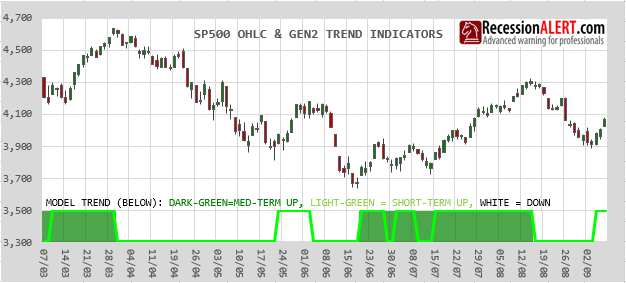
The table below provides aggregated details of all the trends identified since January 2000, which encapsulates three full business cycles. These form the database used to impute probabilities:

2.TRENDS DATA-SET
The dataset used for short-term trends corrections and durations appears below:
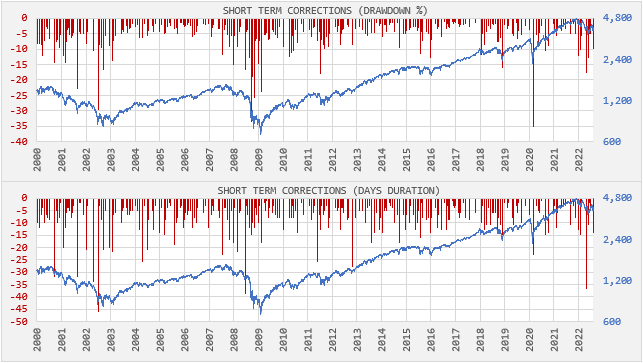
The dataset used for medium-term trends corrections and durations appears below:
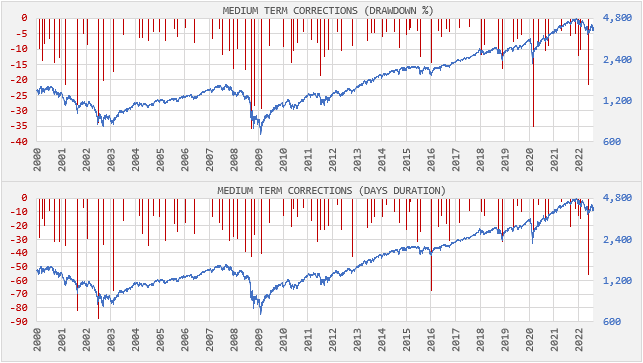
The dataset used for short-term trends rallies and durations appears below:
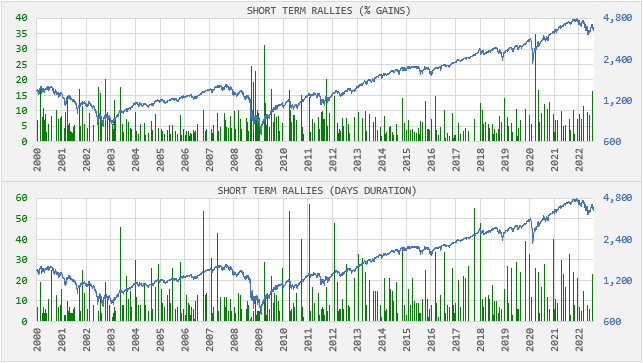
The dataset used for medium-term trends rallies and durations appears below:
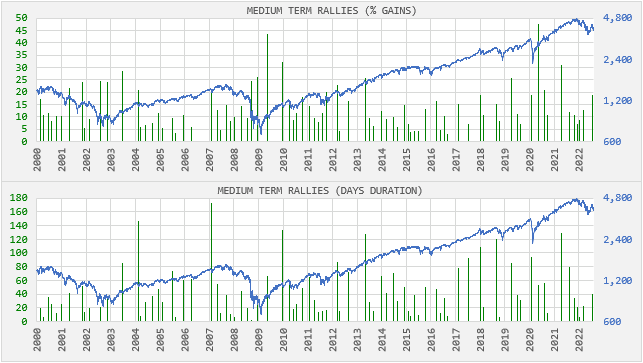
3.IMPUTING PROBABILITIES
The model uses daily open/high/low/close (OHLC) candles of the SP500 to build the corrections/rally historical database and offer daily probability prints. As each correction/rally concludes, it is added to the growing database to improve the sample-set and prediction model. Since we use OHLC candles, the % move calculations always use the High (H) and Low (L) readings to calculate peak-to-trough intraday moves.
As an example, if the current short-term down-trend of SP500 is on a 10% peak-to-trough drawdown, then we can see from the first data-set chart above that only 32 times of the last 270 have short-term corrections got worse. This means only 32/270 = 11.8% of the time in the past has the downtrend got worse than 10%. We can then infer that the probability is 100-11.8=88% (p=0.88) that the current short-term correction is over.
Another example, if the current medium-term rally (up-trend) of the SP500 has been going on for 60 market sessions (60 days) then we can see from the last data-set chart that only 21 times of the last 84 have medium-term up-trends lasted longer. This means only 21/84 = 25% of the time have rallies lasted longer than 60 days. We can then infer that the probability is 100-25=75% (p=0.75) that the current medium-term rally is over.
The chart below shows the imputed probabilities of short and medium-term market tops (peaks) calculated in this manner for both % gains and duration:

The pane at the bottom in above charts merely shows how many of the 4 market top probabilities have exceeded 60, 80 and 90% respectively.
The chart below shows the imputed probabilities of short and medium-term market bottoms (troughs) calculated in this manner for both % gains and duration:

The pane at the bottom of above charts merely shows how many of the 4 market-trough probabilities have exceeded 60, 80 and 90% respectively.
4.USING PROBABILITY DASHBOARD
The probability dashboard is a 6-panel chart system that shows the status of the probability model.
The 1st (top) pane is displayed above and shows SPX OHLC daily candles together with any significant trend lines we deem worth showing. On the bottom of this pane are dark green shading representing the periods defined by the medium-term up-trends, and a light green line demarcating the periods of the short-term up-trends. When no shading or lines are present, we are deemed to be in a down-trend. We also make some forecasts for the current deemed trend based on the statistical database of corrections and rallies. The forecasts run to the median and plus-one standard deviation and depict the targets as well as current % changes required to get there. At the top of the chart in green text, we are representing the close for the prior day, and we show the current candle High, Low & Close (HLC) with 1-day % changes over prior day respectively. We also show the average of the drawdown & duration probability or the gains & duration probability for both current short and medium-term direction.

The 2nd and 3rd panes shown above show these probabilities for gains/losses and duration (in days) respectively. You can use the 80% threshold for reliable, but rare bottom/top signals. The 60% threshold also serves useful when observing the short-term probabilities. Dashed guidelines have been provided for this.

The 4th pane above shows the actual % advance/decline of the current rally or correction. Rallies are represented with positive numbers and corrections with negative numbers. We see from the table in section 1 that average moves are -4.5% and +5.8% for the short-term trends and -8.2% and 10.9% for the medium-term trends. Statistically significant moves of 1 standard deviation are -9% and +10.5% for the short-term trends and -15.7% to 19.4% for the medium-term trends. These usually coincide with 0.8 to 0.9 probabilities. The current gains/losses and the means and distance to the means in standard deviations are shown in the chart legend. In the above example the short-term rally has gained 4.89%, and we are 0.2 standard deviations from the 5.8% gains mean.

The 5th pane above shows the actual duration of the current rally or correction. Rallies are represented with positive numbers and corrections with negative numbers. We see from the table in section 1 that average durations are 7-days (corrections) and 9-days (rallies) for the short-term trends and 20-days (corrections) and 35-days (rallies) for the medium-term trends. Statistically significant durations of 1 standard deviation are 14-days (corrections) and 20-days (rallies) for the short-term trends and 36-days (corrections) and 72-days (rallies) for the medium-term trends. These usually coincide with 0.8 to 0.9 probabilities. The current durations and the means and distance to the means in standard deviations are shown in the chart legend. In the above example the current medium-term correction has been going for 17 days, and we are 0.2 standard deviations from the 20-day mean.

The 6th and final pane as shown above, displays the number of “statistically noteworthy events” we are witnessing for the rally or correction that is underway. Every time a probability reading reaches 0.6, 0.8 and 0.9 a point is awarded. Since there are 4 different probabilities being tracked for each correction/rally (duration short & medium term, %move short & medium term) there is a maximum score of 12. The more statistically noteworthy events occurring, the better, as they represent higher likelihoods. You can view them as confidence levels or levels of conviction. Three or more events are useful, and six or more events particularly useful when assessing risk or opportunity for the SP-500. This section is similar in concept to the Trendex risk/opportunity scores panel in the Trendex charts.
A complete version of the dashboard is shown below:

FINAL NOTES
A twenty-year history for short- & medium-term gains/drawdown and duration probabilities together with probability diffusions, as displayed in section-3 above, is available in “Peak History” and “Trough History” links above the main dashboard, to enable you to assess current readings against historical extremes.

Probabilities of troughs are more useful than probabilities of peaks since detection of market peaks is so much harder than that of troughs. Additionally, statistical extremes in medium-term probabilities are more accurate, practical & representative of tops/bottoms than those in short-term probabilities.
It is important not to use the probability model as an actionable trading signal. You must still deploy your traditional technical analysis methods you normally use for actionable market signals. The probabilities provide you CONTEXT as to the CONVICTION of your traditional technical analysis signals. As an example, if you like using trend line breaks for signals, then you still use these to trigger market actions, but confer with the probability model to see likelihood of success of your market operation.
Trend algorithm lock-ins for statistical database entry exist for candles older than 5 days (short-term trends) and 17-days (medium-term trends). The algorithm forecasts trend direction and changes for younger data points to show probabilities to estimate near-term risk/opportunity but large, unexpected moves 5-17 days in the future can occasionally lead to trend direction revisions. Additionally, near-term trend direction changes require at least 2 days to be recognized. You are thus advised to exercise caution when using the near-term trend indicators for purposes of market timing, as historical data is not fully representative of real-time observations.
For PRO subscribers, GEN2 models exist for SP500 in PRO>SP500 Charts, for the Nasdaq-100 version at PRO>QQQ Charts, a GOLD version at PRO>GLD Charts and a Bitcoin version at PRO>BITCOIN Charts.
New PCT Module
A PCT “Persistent Current Trend” module was more recently introduced to the Gen2 probability model to enhance market timing and risk assessment for subscribers. You can read about it here.
New ST-ALGO Module
A near-term trend-finding tool for short-term market timers or those seeking to assess near-term risks of a trend reversal was also introduced. You can read about it here.


Comments are closed.